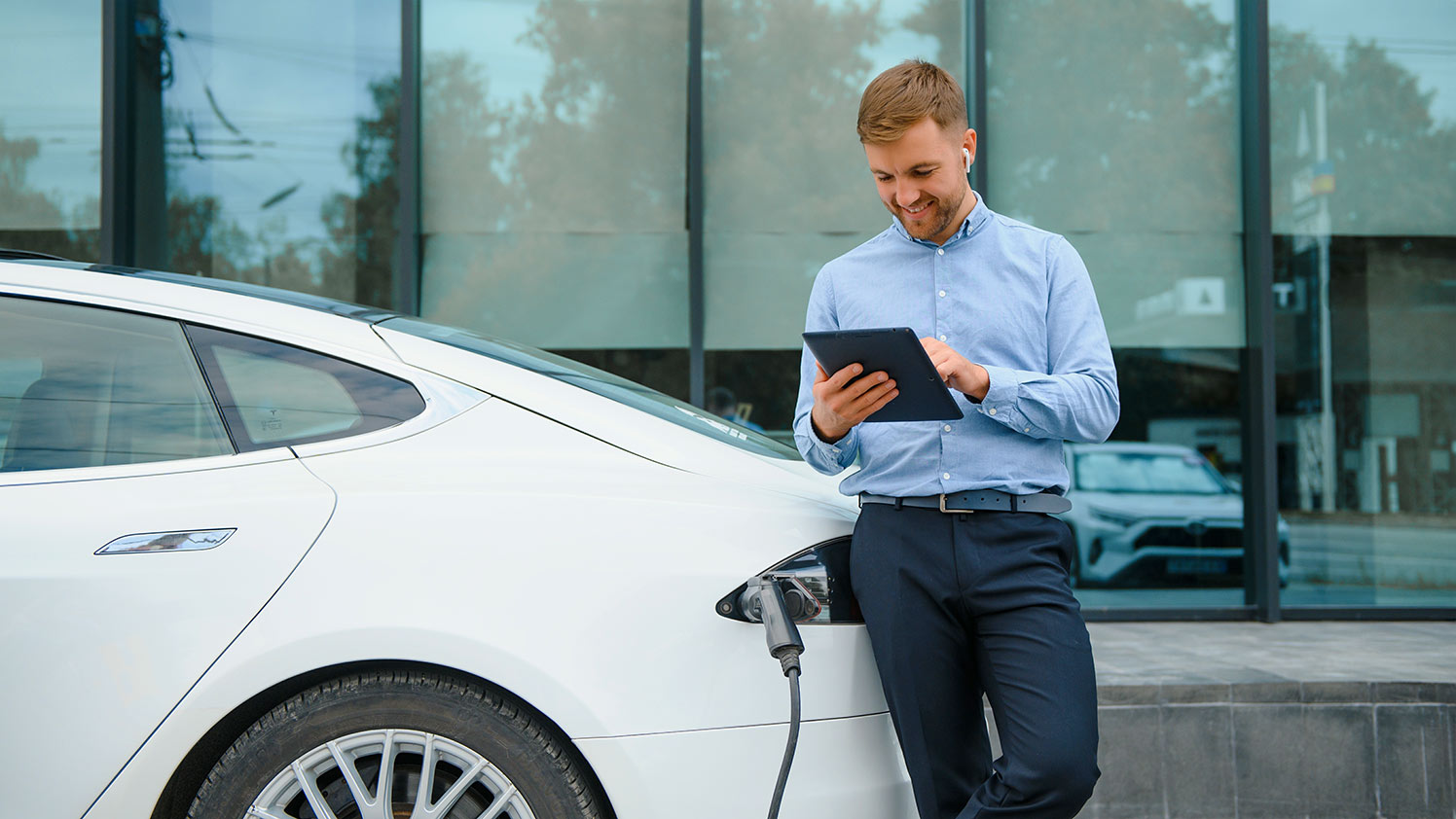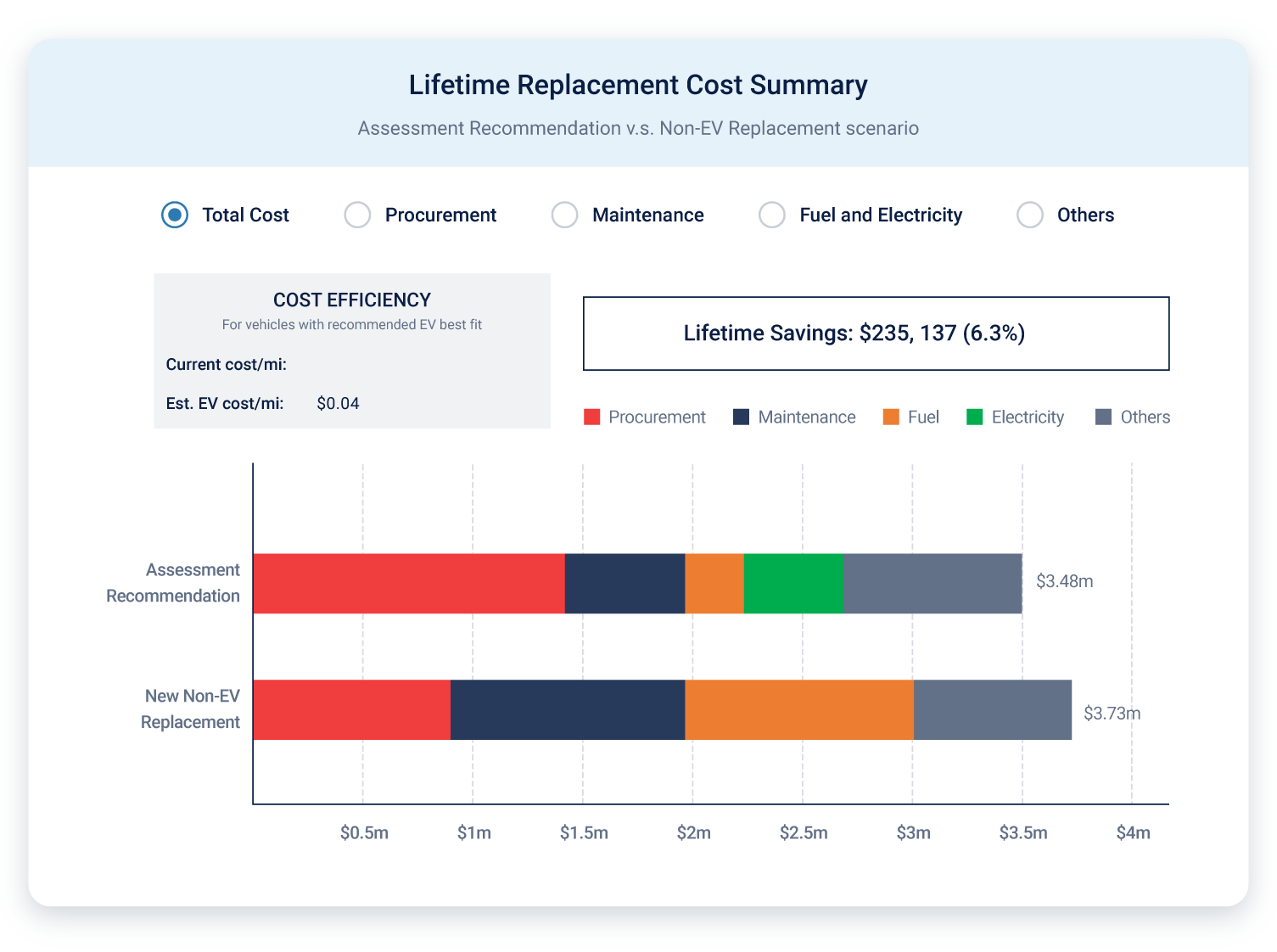Module V - The link between sustainability and savings: Greenify your fleet (and budget) with electrification or alternative fuels
On the road to lower fleet costs, sustainable vehicles can slash fuel costs. Are your internal combustion engine (ICE) vehicles burning too much fuel and money?
Is your agency feeling the pressure of high fuel expenses and taxpayer expectations? Driving down fuel consumption and related costs starts with an honest, data-driven assessment of the ways in which your fleet vehicles currently consume fuel and creating new strategies to curb waste. One of the most beneficial ways to optimize your fuel management is to transition to electric (EV), hybrid or alternative fuel vehicles. These types of cars can replace any high-emitting vehicles currently in your fleet, saving you—and your constituents—money over time. This module will explain the many ways EVs, hybrids and alternative fuel vehicles can reduce your agency’s costs, how to plan a more sustainable and budget-friendly government fleet and key strategies to position it for success.
How do sustainable vehicles save my department money?
While lower fuel expenditure is surely one of the most significant benefits of sustainable vehicles, reduced costs can also be found in other areas. Savings can extend into categories of fleet expenses like vehicle maintenance, enabling your budget to be more flexible and allowing you to reinvest money into other key areas of your operations. While driving savings in your fleet, sustainable vehicles additionally help reduce harmful emissions that can lead to higher air pollution and in certain locations, avoid carbon taxes.
All of these benefits make a switch to sustainable vehicles worthwhile to consider. However, for the purposes of this module, we will focus primarily on the financial benefits of EVs, hybrid and alternative fuel vehicles. Amid calls for agencies to become more efficient and spend public funds as responsibly as possible, here are several of the top ways sustainable vehicles can free up valuable space in your budget.

Fewer fill-ups
With more EVs and hybrid models in your fleet, you’ll have fewer ICE vehicles to fill up with gasoline each day, leading to saved time and less frequent trips to the pump. Reduced fuel costs through lower consumption is one of the strongest ways to justify adding sustainable vehicles to your fleet.
Immunity to fuel price fluctuations
With external factors like geopolitical affairs, the national economy and consumer behaviors all greatly influencing fuel price changes, it can be challenging to consistently plan your fleet’s fuel budget. However, EVs are resistant to shifting gas prices by being powered solely on electricity. Adding them to your fleet can help create valuable elasticity in your budget.
Preventing fuel burn during idling
According to the North Carolina Department of Environmental Quality, the average car burns one-fifth of a gallon of gas per hour of idling. Multiplied across each day in a week and each vehicle in a fleet, costs from this behavior can add up significantly. Thankfully, idling in EVs only drains their batteries. By switching to EVs, you’ll eliminate the potential for fuel to be burned while idle and save more money.
Lower total cost of ownership (TCO)
When purchasing or leasing new vehicles for their fleet, fleet managers should always consider the TCO before making a decision. TCO refers to the overall expenses an owner or leasee can expect to incur over the lifetime of the vehicle, including repairs, fuel and up-front costs. In total, EVs tend to have lower costs of ownership than ICE vehicles, and as newer models hit the market, this gap is increasing.
Maintenance savings
EVs can deliver savings in the form of fewer repairs and maintenance over time. As EVs have fewer parts than ICE vehicles, their chances of having parts malfunction are generally lower. This helps keep your vehicles out of mechanic shops and on the road instead. Additionally, there is no need to perform routine oil changes with EVs, which also helps to reduce your fleet costs.
Did you know?
Research from the National Renewable Energy Laboratory shows that EVs can provide an average lifetime savings of $3,000 to $10,500 on fuel expenses (compared to gasoline-powered vehicles).
Carving a path to a sustainable and cost-efficient government fleet
Now that the cost-saving benefits of sustainable vehicles have been outlined, knowing how to develop a plan for procurement is the next step. If you want to explore the possibility of an EV fleet, where do you start? With so many EV, hybrid and alternative fuel vehicle options available, it can be challenging to know which are most suitable for your agency and what to do with the ICE vehicles currently in your fleet.
In this chapter, we’ll provide a comprehensive how-to guide for implementing sustainable vehicles with telematics. From initial assessment of your current operations to choosing your new vehicles and forecasting their utilization, these steps will show you how to smoothly transition to a more sustainable fleet.

Survey the scope of your operations
Before jumping into the acquisition phase, it’s imperative to take in a bird’s-eye level view of your agency’s operations. Identify which of your vehicles have the highest operating costs per mile or with the highest fuel consumption costs to know which of your current vehicles are most expensive. Additionally, ask questions such as:
- Where are my employees asked to drive most often?
- Are there typically different locations each day, or do some of my staff frequently visit the same locations?
- What are the geographical boundaries of the jurisdiction your agency serves?
Asking key questions like these will help you know whether range limits should be a concern for your new vehicles and make it easier to buy or rent capable EVs from the start.
Assess which vehicles are suitable for electrification
It’s wise to survey fleet electrification opportunities before acquiring EVs because it can help your agency scale EV adoption in a more cost-efficient and manageable way. Determine which ICE vehicles are the best candidates for EV replacement, forecast potential savings and choose effective EVs based on a variety of specific factors. One way to do this is with Geotab’s Electric Vehicle Suitability Assessment (EVSA), which takes into account charging locations, charging states and dwell times—as well as the preferences of your fleet—to help you build an ironclad business case for EVs. Compare EV costs and assess total cost of ownership (TCO) data with Geotab’s EVSA to make more informed financial decisions and help drive continued ROI. Conducting an EVSA makes navigating a path to sustainability simpler and more manageable to do, reducing the guesswork involved and providing you with a well-researched blueprint for electrification and cost savings. Additionally, you should look into how EV charging infrastructure will be set up or accessed for your fleet. Will your employees be doing at-home charging, or will you strategically place new charging stations in your region to support government vehicles? Asking these questions can help eliminate barriers and foster a smooth transition to EVs for your fleet.
Determine vehicle purposes
Once you’ve identified quality sustainable vehicle candidates based on your agency’s needs, plan your vehicles’ purposes to make sure they’ll receive maximum usage. Planning utilization patterns in advance will help you determine mileage expectations, schedule charge or refueling times effectively to limit costly downtime and conquer any EV range anxiety you might be feeling. Plus, priming your new EVs for optimized usage ahead of time helps you avoid future expenses from underutilization later on.
Plan for a phased approach
When it’s officially time to procure sustainable vehicles, look for the most economical replacement options based on the research you’ve done. For a seamless transition, acquire vehicles in a piecemeal approach by replacing your highest-emitting vehicles first. By scalably adding sustainable vehicles to your fleet, you’ll be able to swap out your costliest vehicles quickly, efficiently manage up-front costs and give your fleet time to adjust to the new vehicle types.

Putting your sustainability plan into action to decrease expenses
Once you’ve added EVs, hybrids or alternative fuel vehicles to your fleet, you’ll want to monitor all vehicle types for their operating costs. Doing this will help you make adjustments to remain on track with your agency’s savings. Examining charging costs by location, driver and vehicle will allow you to identify inefficiencies. Comparing monthly operating costs based on vehicle type will empower you to make data-driven procurement plans that optimize your fleet budget.
As you scale electrification or hybridization across your fleet, it’s critical to forecast future cost savings prior to acquiring each new vehicle. If there isn’t a strong business case or a clear path to ROI after what an up-front investment would cost, it likely isn’t worth it to add more sustainable vehicles to your fleet. Always remember to look for ways to continuously optimize your fleet’s expenses, and never get complacent on the road to lower costs.
How telematics drives cost savings through sustainability
With telematics, you can reduce expenses by designating routes for EVs based on accurate range estimates. Study reports on battery capacity and usage, using near real-time charge statuses to assign the best vehicle for a job. Plus, with a staggered method for vehicle charging, you can efficiently manage electricity demand and keep more of your vehicles available for work. When too many vehicles are requiring a charge, it can result in unnecessary downtime that costs your agency even more money through lost productivity. Effectively planning charging schedules helps you maximize taxpayer funds and enhances your service to the public. With Geotab’s sustainability features, you can also keep costs lower by reviewing historical data to see times when charging is cheapest.
Telematics solutions can help you prudently spend public funds by showing you areas of your operations where high-emissions vehicles are hurting your budget most. Using a fleet management solution and these insights, achieve higher fleet savings with sustainability as the driving force.

Did you know?
Natural Resources Canada
With Geotab’s EVSA, Natural Resources Canada forecasted a potential TCO savings of roughly $15.6 million and 7.8 million liters of fuel over the lifetime of a lower-carbon fleet.